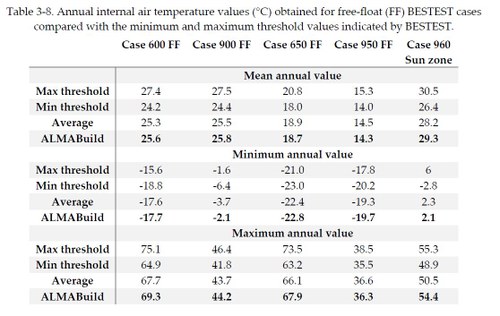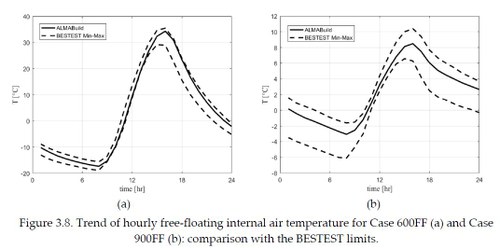Free floating cases

The fourth comparative test suggested by BESTEST concerns the prediction of the trend of internal air temperature in a room in free-floating conditions. Since this parameter is obtained as result of an energy balance among the heat fluxes exchanged by all the elements involved in the thermal zone, the comparison of the indoor air temperature becomes a method for the verification of the right solution of the energy balance of a thermal zone. This last step is very important for assessing the reliability of ALMABuild, because the internal air temperature is correctly evaluated only if all the heat fluxes are calculated in a proper way and if the thermal inertia of all the envelope components is adequately taken into account.
In the following Table for each case analysed, the annual mean, maximum and minimum indoor air temperature values obtained by using ALMABuild are reported together with the maximum and minimum threshold values obtained for the same cases by the reference software cited by ASHRAE Standard 140.
Observing the data in the Table, one can observe how the results obtained with ALMABuild are in between the minimum and maximum threshold values defined by BESTEST in all the reference cases.

In addition to evaluation of the mean, minimum and maximum annual indoor temperature, the BESTEST procedure requires also the comparison of the hourly profile of the indoor temperature for two specific days.
The Figure on the left shows the hourly profile of the internal temperature evaluated with ALMABuild (solid line) compared with the maximum and minimum profiles (dashed lines) reported by the BESTEST report for case 600FF (a) and case 900FF (b).
Since case 600FF differs from case 900FF only for the external wall composition, comparing these two figures it is possible to appreciate the effect of the thermal inertia of the walls on the internal air temperature trend. It can be noted that the amplitude of the variation of the internal air temperature is very high (±25 K) in case 600FF (lightweight walls), whilst for the Case 900FF (heavyweight wall) this variation is limited to few Kelvin (±6 K). Also in these cases, the temperature profile obtained with ALMABuild is in good agreement with the BESTEST results.